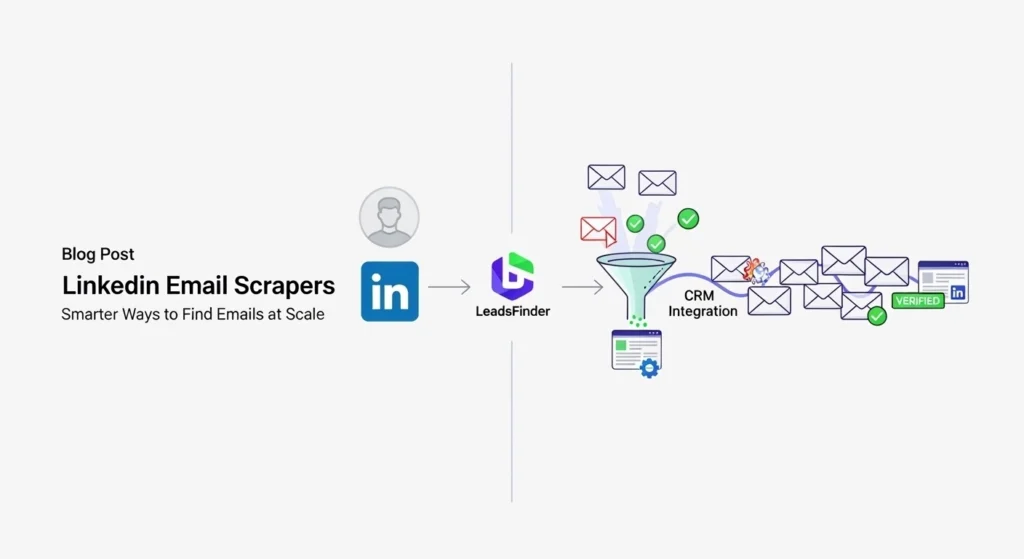Table of Contents
You’re Not Alone—Scraping Emails from LinkedIn Is a Grind
Let’s be honest. If you’re in sales, marketing, or any kind of outbound role, you’ve probably Googled “LinkedIn email scraper” at some point. Maybe even tried a few Chrome extensions that promised verified email lookup from LinkedIn profiles. Some worked, some didn’t, and a few probably got your LinkedIn account restricted. Sound familiar?
We get it—we’ve been there too.
Here at LeadsFinder, we’ve run over 100+ campaigns where LinkedIn scraping was either the starting point or part of a larger prospecting system. And through that, we’ve learned what works, what fails, and what gets your profile in hot water.
This blog breaks down everything you need to know about LinkedIn email scraper—from the tools, techniques, and ethics to smarter, scalable alternatives that actually grow your pipeline without risking your account.
Why Everyone’s Obsessed with LinkedIn Email Scrapers
LinkedIn = The Holy Grail of B2B Leads
LinkedIn is still the #1 source for B2B leads, especially for high-ticket, targeted sales.
Decision-makers live here. Their job titles, company names, tech stack, industry, and activity feed—it’s all gold.
But LinkedIn’s messaging system is clunky. InMail has low open rates. So naturally, people want verified business emails to run cold outreach campaigns off-platform.
But Here’s the Problem
Most “scrapers” either:
- Violate LinkedIn’s TOS, risking shadow bans or account bans
- Provide unverified or outdated emails
- Require constant manual input
- Don’t scale well for serious prospecting
So… what’s the smarter play?
The Real Options for LinkedIn Email Extraction
1. Chrome Extensions: Quick but Risky
These browser plugins (like Skrapp, Snov.io, GetProspect) work while you scroll through LinkedIn. Handy? Sure. But risky? Also yes.
Why people use them:
- Easy to install
- You just browse, and emails pop up
Why they can bite back:
- LinkedIn notices this stuff—fast
- Accuracy is meh unless you’re verifying afterward
- Doing this at scale? Bring coffee and patience
2. API-Based Scrapers: Don’t Do It
Now this is where folks get too clever. Some devs try to work around LinkedIn’s front-end using shady APIs. We’ve tested one—our test account was flagged in five days.
You don’t want that. Just don’t.
3. Enrichment Platforms: The Smarter Play
You grab a LinkedIn profile or company domain, drop it into a platform like LeadsFinder, and it spits out real, verified contact data. No scraping. No Terms of Service drama.
Top tools in this lane:
- Us (LeadsFinder.tools)
- Apollo
- Clearbit
- UpLead
Why this wins:
- You get verified emails tied to job roles and companies
- Works at volume
- TOS-safe
- Plays nicely with CRMs like HubSpot or Close.io
Finding Emails Without Breaking the Rules
Step 1: Target Precisely with Sales Navigator
Use filters like:
- Seniority: “Head of”, “VP”, “Director”
- Company size: SMB? Enterprise?
- Region or market focus
- Technology used
Collect URLs or identifiers—manually or using export tools.
Step 2: Feed Them into LeadsFinder
Upload LinkedIn URLs or company domains directly into LeadsFinder.
We give you:
- Verified business emails
- Names, job roles, and contact numbers
- Company size, industry, funding, tech stack info
Step 3: Launch Smarter Campaigns via CRM
Plug that enriched data into your CRM (we support HubSpot, Salesforce, and more).
Then:
- Set up automated drip sequences
- Create personalized templates
- Trigger follow-ups based on engagement (opens, clicks, replies)
Rookie Mistakes to Skip
- Skipping verification: Even if you scraped it, it might bounce. Validate it.
- Trusting browser plugins blindly: Many guess email formats without confirming.
- No personalization: Raw email data is just that—raw. Add context like recent funding or job shifts.
- Not watching bounce rates: Too many bounces = your domain’s reputation gets wrecked. Use warm-up tools + suppression lists.
Smarter Alternatives to Email Scraping
| Prospecting Strategy | What It Does | Tools We Like |
|---|---|---|
| Intent Data | Find buyers researching your product category | Bombora, Leadfeeder |
| Domain-Based Lookup | Match company sites to emails by role | LeadsFinder, Hunter.io |
| Community Sourcing | Leads from platforms like Reddit, Twitter, Slack | SparkToro, Common Room |
| Content-Based Lead Gen | Content-Based Lead Gen | ConvertBox, Typeform |
What We’ve Learned (After 300+ Campaigns)
- Scraping is fragile—enrichment is scalable
- Verified email + phone = 2–3x reply rate
- Automating campaigns saves time, but relevance is your real secret weapon
Final Thoughts: Smarter Prospecting Wins
Let’s call it what it is: scraping emails from LinkedIn might feel efficient—but it’s high-risk, low-return. You deserve better.
Tools like LeadsFinder let you ethically and efficiently find the people you need to reach—without the anxiety of account bans or bounce rates.
So yeah, scrape less. Enrich more. Win more deals.
Bonus: Follow-Up Template You Can Steal
Subject: Still a priority for [Quarter]?
Body: Hey [First Name],
Saw you’re heading up [Role] at [Company]. We recently helped a similar team solve [pain point] using [solution]. Think it’s worth a quick chat?
Either way—have a smooth week ahead.
— [Your Name]
FAQs
Q1: Is it okay to use LinkedIn email scrapers?
Scraping directly from LinkedIn is against their terms and could land you in trouble. Plus, you might end up with bad data. Safer to use enrichment tools.
Q2: What’s the safest way to get LinkedIn emails?
Use tools like LeadsFinder that source verified emails via company domains and LinkedIn profile URLs—fully above board.
Q3: Can I do cold outreach without scraping anything?
Totally. Target your prospects using Sales Navigator, enrich externally, and plug that data into your email outreach or CRM system.
